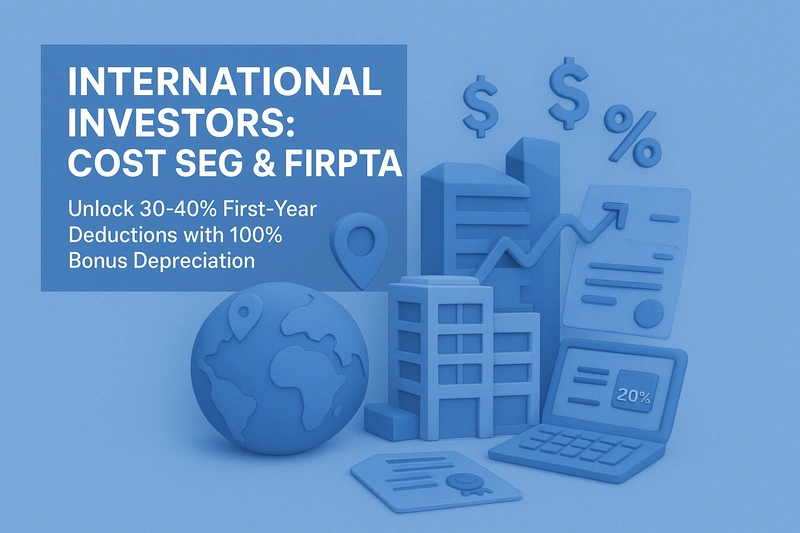International investor cost segregation presents unique opportunities and challenges. Foreign investors must balance aggressive depreciation strategies against FIRPTA withholding obligations, home country tax treaties, and complex reporting requirements. The restoration of full bonus depreciation amplifies these considerations, making proper planning essential.
R.E. Cost Seg has analyzed thousands of international investment properties, identifying strategies that maximize tax efficiency while maintaining full compliance.
The key lies in understanding how accelerated depreciation interacts with FIRPTA disposition rules and structuring investments to capture maximum benefits.
This comprehensive guide examines the intersection of cost segregation and FIRPTA for foreign investment portfolios. You'll discover specific strategies for leveraging permanent bonus depreciation, minimizing withholding requirements, and structuring exits that preserve accumulated tax benefits.
What Makes International Investor Cost Segregation Different?
International investors face distinct considerations when implementing cost segregation strategies. Unlike domestic investors, foreign entities must navigate both U.S. tax obligations and home country reporting requirements. R.E. Cost Seg regularly encounters international clients who underestimate the documentation complexity involved in cross-border property investments.
U.S. tax compliance for foreign-owned entities requires meticulous record-keeping. Form 5472 reporting obligations apply to most international structures, with substantial penalties for non-compliance.
Cost segregation studies for international investors must meet enhanced documentation standards, providing defensible positions for both IRS scrutiny and foreign tax authority review.
Ownership structures significantly impact cost segregation benefits. Foreign corporations, partnerships, and disregarded entities each trigger different U.S. tax consequences.
Many international investors establish U.S. blocker entities to simplify reporting and optimize depreciation benefits.
The Strategic Value Proposition
Cost segregation delivers measurable benefits for international real estate portfolios:
- Accelerated Cash Flow: Reclassifying 20% to 40% of building costs into 5, 7, and 15-year recovery periods
- FIRPTA Offset Potential: Depreciation deductions reduce U.S. taxable income subject to withholding
- Treaty Optimization: Coordinating U.S. depreciation with home country tax benefits
- Loss Harvesting: Creating suspended losses for future U.S. income offset
Financial Example: International Office Building Acquisition
Consider a German investor purchasing a $10 million Dallas office complex:
Traditional Depreciation:
- Building basis (excluding land value): $8 million
- Annual depreciation: $205,128 (39-year straight-line)
- 10-year tax savings at 37% rate: $758,974
With Cost Segregation + 100% Bonus Depreciation:
- Personal property identified: $2.4 million (30% of building)
- Year 1 deduction: $2.4 million
- Immediate tax savings: $888,000
- 10-year NPV advantage: $652,000
The site visit revealed substantial qualifying assets: specialized electrical systems, moveable partitions, decorative fixtures, and dedicated cooling systems. These components qualify for immediate expensing under current bonus depreciation rules.
International investors must consider recapture implications at disposition. Accelerated depreciation creates ordinary income recapture exposure, potentially increasing FIRPTA withholding certificates. Strategic planning minimizes this impact through proper exit timing and structure.
FIRPTA Overview for Real Estate Investors
FIRPTA requires 15% withholding on gross proceeds when international investors dispose of U.S. real property interests. This withholding applies regardless of actual gain or loss, creating significant cash flow implications for foreign sellers. The interaction between FIRPTA and accelerated depreciation from cost segregation requires careful planning.
Foreign investment structures must account for FIRPTA from acquisition. The standard 15% withholding often exceeds actual tax liability, particularly for properties with minimal appreciation.
International investors can apply for withholding certificates to reduce this burden based on actual gain calculations. R.E. Cost Seg assists clients in documenting depreciation positions for these applications.
Exceptions exist for certain transactions. Properties selling below $300,000 avoid FIRPTA withholding when purchased by individual buyers who intend to use the property as their primary residence for at least 50% of the time during the first two years after purchase. Publicly traded REIT shares and certain qualified foreign pension fund investments also receive favorable treatment.
Integration with Cost Segregation
FIRPTA depreciation considerations directly impact exit strategies. Accelerated depreciation through cost segregation creates two distinct recapture categories:
- Section 1245 Property: Personal property and land improvements are subject to ordinary income recapture upon sale (up to the amount of depreciation taken).
- Section 1250 Property: Building and structural components generally receive capital gains treatment, but the portion of gain attributable to depreciation is taxed as “unrecaptured Section 1250 gain” at a maximum rate of 25%. However, foreign corporations face regular corporate rates on all gains, including depreciation recapture, with no preferential treatment
International investors using corporate structures must plan for higher recapture rates. Form 3115 establishes the depreciation change, creating permanent tax records affecting future FIRPTA calculations.
How does accelerated depreciation affect my FIRPTA withholding at sale?
FIRPTA withholding applies to gross proceeds, not taxable gain. However, depreciation recapture increases actual tax liability at disposition. International investors should apply for withholding certificates showing the actual tax due.
R.E. Cost Seg provides detailed depreciation schedules supporting these applications. Many clients reduce withholding from 15% to 5% or less through proper documentation.
Strategic timing matters. Holding periods exceeding five years often optimize the balance between depreciation benefits and recapture exposure.
The Game-Changing Opportunity
The Big Beautiful Bill permanently restored 100% bonus depreciation, eliminating phase-out uncertainty that plagued international investment planning. Foreign investors can now model long-term acquisitions with confidence, knowing full immediate expensing remains available.
This permanence transforms cost segregation from a timing strategy into a fundamental investment advantage.
R.E. Cost Seg identifies qualifying property components eligible for bonus depreciation during every site visit. International investors regularly discover 25% to 45% of building costs qualify for accelerated treatment. Immediate expensing applies to assets with recovery periods under 20 years that are not required to use the Alternative Depreciation System (ADS). Qualified improvement property (QIP) qualifies only if used predominantly within the U.S.
Strategic Applications for Foreign Investors
International portfolios benefit from targeted depreciation strategies:
- Income Offset: Immediate deductions shelter U.S. rental income from taxation
- Loss Banking: Excess depreciation creates net operating losses for future use
- Treaty Coordination: Aligning U.S. deductions with foreign tax credit positions
- Portfolio Staging: Sequencing acquisitions to maximize annual benefit capture
Financial Example: Bonus Depreciation Impact
A Canadian investor acquires a $15 million Phoenix retail center:
Without Cost Segregation:
- Annual depreciation (excluding land value): $307,692
- 10-year deductions: $3,076,920
With Cost Segregation + Bonus Depreciation:
- Year 1 bonus depreciation: $4,500,000
- Immediate tax savings at 37%: $1,665,000
- Net present value advantage: $1,247,000
Entity Selection Impact
International investors must choose structures that balance U.S. tax efficiency with home country requirements. Foreign corporations face double taxation on U.S. real estate income but provide familiar governance structures. Partnership formations offer pass-through taxation while maintaining liability protection. R.E. Cost Seg analyzes entity choices during initial cost segregation planning.
U.S. blocker corporations shield foreign investors from direct U.S. filing requirements. These entities claim depreciation deductions directly, simplifying international reporting. REITs provide additional options, potentially eliminating entity-level taxation while maintaining FIRPTA exemptions for qualified foreign pension funds.
Treaty Benefits and Cost Segregation
Tax treaties significantly impact depreciation strategies. Many treaties reduce U.S. withholding rates on rental income, improving cash flow from accelerated depreciation. International investors must coordinate cost segregation benefits with treaty positions to avoid unintended consequences.
Transfer pricing rules apply when related foreign entities provide financing or management services. Depreciation deductions must align with arm's length principles. Site visits document property-specific improvements supporting transfer pricing positions.
Should international investors form a U.S. entity to hold property?
U.S. entities generally optimize cost segregation benefits while simplifying compliance. LLCs taxed as partnerships provide flexibility, allowing special allocations of depreciation. Corporate structures work better for investors planning multiple property acquisitions. R.E. Cost Seg guides entity formation based on specific investment objectives and home country considerations.
Documentation Challenges
International investors face heightened IRS scrutiny requiring comprehensive documentation. Common compliance failures include:
- Form 5472 Reporting: Missing deadlines triggers $25,000 penalties per form
- Cost Segregation Study Quality: Inadequate engineering detail invites IRS challenges
- Asset Classification Errors: Misidentifying land improvements as building components
- Basis Allocation: Incorrectly separating land value from depreciable property
R.E. Cost Seg provides IRS-defensible studies meeting audit standards. Detailed site visit reports document every reclassified component with photographic evidence and engineering analysis.
Depreciation Recapture Planning
Recapture rules create unexpected tax liability for unprepared international investors. Section 1245 property faces ordinary income rates on accumulated depreciation. Building components under Section 1250 receive favorable capital gains treatment. Form 3115 modifications establish permanent recapture obligations.
Strategic solutions minimize recapture impact. Cost segregation timing affects holding period decisions. Properties held beyond recovery periods reduce recapture exposure. Replacement property identification preserves depreciation benefits through continued investment.
Can international investors combine cost segregation with 1031 exchanges?
Yes, but coordination is essential. Personal property depreciation (5 and 7-year assets) requires careful replacement property selection. The exchanged property must include sufficient short-life components to defer recapture. R.E. Cost Seg performs pre-exchange analysis identifying optimal replacement properties. International investors should engage qualified intermediaries familiar with foreign ownership structures.
Pre-Acquisition Planning
International investors maximize cost segregation benefits through early engagement. R.E. Cost Seg recommends these critical steps:
- Engage Professionals Before Closing: Commission feasibility analysis during due diligence
- Structure Entity Formation: Establish U.S. entities optimized for depreciation benefits
- Review Tax Treaties: Confirm home country treatment of U.S. depreciation
Post-Acquisition Optimization
- Commission Studies Immediately: Complete cost segregation within the acquisition year
- File Form 3115: Establish depreciation positions through proper elections
- Claim 100% Bonus Depreciation: Maximize benefits under Big Beautiful Bill provisions
- Document Everything: Maintain records supporting international investor cost segregation
Exit Strategy Considerations
Smart disposition planning preserves accumulated benefits:
- FIRPTA Withholding Certificates: Apply early, showing actual tax liability
- Installment Sales: Spread recapture across multiple years
- 1031 Exchanges: Defer recognition through continued investment
Real estate professional status enhances flexibility. International investors meeting the hour requirements unlock additional loss utilization opportunities. R.E. Cost Seg guides clients through qualification requirements and documentation standards.
State and Local Tax (SALT) Considerations
International investors must navigate complex state tax obligations beyond federal requirements. State income tax rates vary significantly, from zero in states like Texas and Florida to over 13% in California. These differences dramatically impact net returns on cost segregation benefits.
Property tax implications deserve special attention. Many states impose transfer taxes on foreign buyers or maintain different assessment standards for international ownership. Some jurisdictions require state-specific withholding on property sales by foreign entities, adding layers beyond FIRPTA requirements.
State nexus rules determine filing obligations. Owning real property typically creates nexus, triggering state tax filing requirements. Multi-state portfolios face combined reporting obligations, potentially affecting depreciation deduction allocation. International investors should analyze state conformity to federal depreciation rules. Some states decouple from federal bonus depreciation, requiring separate depreciation schedules.
R.E. Cost Seg coordinates federal cost segregation studies with state tax planning. State-specific considerations include:
- Withholding Requirements: California requires 3.33% withholding on sales by foreign entities
- Composite Returns: Some states allow simplified filing through composite returns
- Apportionment Factors: Multi-state investors must allocate income using state-specific formulas
- Local Tax Obligations: Cities like New York impose additional taxes on foreign investors
ECI vs. FDAP Income Distinction
International investors must understand the critical distinction between Effectively Connected Income (ECI) and Fixed or Determinable Annual or Periodical (FDAP) income. This classification affects tax rates, withholding requirements, and cost segregation benefits.
Rental income from active property management typically qualifies as ECI, subject to graduated tax rates and eligible for depreciation deductions. Passive rental income may constitute FDAP, facing 30% withholding without deduction benefits. Cost segregation studies support ECI treatment by documenting active management involvement.
Foreign corporations with ECI face potential branch profits tax at 30% on deemed dividend distributions. Treaty rates may reduce this burden to 5% or eliminate it entirely. Branch profits tax calculations consider depreciation deductions, making cost segregation particularly valuable.
How do we ensure rental income qualifies as ECI for depreciation benefits?
Active management activities establish ECI treatment. These include regular property maintenance decisions, tenant selection, and capital improvement planning. R.E. Cost Seg documents management activities during site visits, supporting ECI classification. International investors should maintain detailed records of management decisions and time spent on property operations.
Specific Asset Class Strategies
Different property types offer unique cost segregation opportunities. R.E. Cost Seg has identified optimal strategies for major asset classes:
Multifamily Properties
Multifamily investments typically yield 25% to 35% in short-life property. Key components include appliances, carpeting, vinyl flooring, window treatments, and dedicated HVAC units. Exterior improvements like parking lots, landscaping, and recreational facilities qualify for 15-year treatment. International investors benefit from recurring replacement cycles, creating continuous depreciation opportunities.
Hotels and Hospitality
Hotels and hospitality properties generate the highest cost segregation benefits, often exceeding 40% of building costs. Furniture, fixtures, and equipment (FF&E) qualify for 5-year treatment. Decorative elements, specialty lighting, and themed components receive accelerated depreciation. Kitchen equipment, laundry facilities, and recreational amenities provide additional opportunities.
Industrial and Warehouse
Industrial properties contain specialized systems qualifying for accelerated depreciation. Material handling equipment, specialized electrical systems, and process cooling receive 5 to 7-year treatment. Dock equipment, specialized ventilation, and security systems enhance segregation potential. International logistics companies particularly benefit from these classifications.
Retail Centers
Retail properties offer 20% to 30% segregation potential through tenant improvements, specialty lighting, and signage. Food court equipment, decorative elements, and parking lot improvements qualify for acceleration. International investors should coordinate tenant improvement allowances with depreciation strategies.
Energy Tax Credits Integration
The Inflation Reduction Act expanded energy incentives, creating additional opportunities for international investors. Section 179D allows deductions up to $5.65 per square foot for energy-efficient commercial buildings meeting prevailing wage requirements. These benefits stack with cost segregation advantages.
R.E. Cost Seg coordinates energy audits with cost segregation studies. International investors installing solar panels, efficient HVAC systems, or LED lighting capture multiple benefits. The 30% Investment Tax Credit for solar installations combines with accelerated depreciation for maximum advantage.
Prevailing wage and apprenticeship requirements affect benefit levels. International investors must document compliance to claim enhanced deductions. Energy improvements often qualify as 5-year property under cost segregation analysis, maximizing first-year benefits.
Can foreign pension funds claim energy tax credits?
Qualified foreign pension funds generally cannot directly claim tax credits. However, partnership structures with U.S. taxpayers can monetize credits through allocation agreements. R.E. Cost Seg assists in structuring investments to capture available energy incentives while maintaining FIRPTA exemptions.
Technology and Compliance Tools
Modern technology streamlines international tax compliance. Cloud-based depreciation software tracks assets across multiple currencies and jurisdictions. Automated Form 5472 preparation reduces compliance burden and penalty exposure.
R.E. Cost Seg utilizes advanced modeling software for accurate asset identification. Digital site visit documentation provides audit-ready support for classifications. Real-time recapture calculations help international investors evaluate disposition strategies.
Integration capabilities connect cost segregation data with international accounting systems. Multi-currency reporting accommodates home country requirements while maintaining U.S. compliance. Automated alerts notify investors of filing deadlines and required documentation.
Recent IRS Guidance and Case Law
Recent Technical Advice Memorandums clarify cost segregation positions for international investors. The IRS continues focusing on proper documentation and engineering-based studies. International ownership structures face enhanced scrutiny, requiring detailed support for depreciation positions.
Court decisions consistently uphold quality cost segregation studies. The Tax Court emphasizes engineering analysis over arbitrary allocations. International investors benefit from precedents supporting aggressive but documented positions.
IRS audit activity targets inadequate Form 5472 compliance and unsupported depreciation claims. The Large Business and International Division coordinates examinations of foreign-owned entities. R.E. Cost Seg studies meet IRS audit standards, providing necessary documentation for examination defense.
Safe harbor elections protect international investors from challenge. Revenue Procedure 2022-14 provides automatic consent for depreciation method changes via Form 3115. Protective elections preserve flexibility for future optimization.
Estate Planning Considerations
International investors face U.S. estate tax on American real property holdings exceeding $60,000. This low threshold catches many foreign investors unaware. Cost segregation affects estate valuations through accumulated depreciation adjustments.
Step-up in basis at death eliminates depreciation recapture for heirs. However, international estates may not qualify for stepped-up basis treatment. Proper structuring through foreign corporations or trusts can minimize estate tax exposure while preserving depreciation benefits.
Generation-skipping transfer taxes apply to transfers exceeding exemption amounts. International dynasty trusts may own U.S. real estate while minimizing transfer tax exposure. Cost segregation studies document values for estate planning purposes.
Financing and Debt Considerations
Accelerated depreciation impacts lending metrics. Debt service coverage ratios improve through reduced tax payments from cost segregation. International lenders increasingly require cost segregation analysis in underwriting packages.
Section 163(j) limits interest deductions to 30% of adjusted taxable income. Depreciation deductions affect this calculation, potentially restricting interest deductibility. International investors must model the interaction between accelerated depreciation and interest limitations.
Cross-border financing structures complicate depreciation planning. Related-party debt requires arm's length pricing documentation. Cost segregation studies support transfer pricing positions by documenting U.S. property investments. R.E. Cost Seg coordinates with international tax advisors, ensuring optimal debt structuring.
Maximize Your U.S. Real Estate Returns
International investor cost segregation, combined with permanent 100% bonus depreciation, creates exceptional tax advantages. Foreign investors implementing these strategies typically achieve 30% to 40% first-year deductions on U.S. real estate acquisitions. Proper planning minimizes FIRPTA depreciation recapture while maximizing cash flow benefits.
Success requires coordinated execution. Cost segregation services must align with international tax treaties, entity structures, and exit strategies. The Big Beautiful Bill's permanent bonus depreciation eliminates timing uncertainty, allowing strategic long-term planning.






